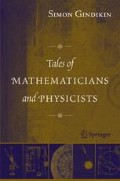Abstract
Vincenzio Galilei, a well-known Florentine musician, had reflected for a long time on what field to choose for his oldest son Galileo. The son was undoubtedly talented in music, but the father preferred something more reliable. In 1581, when Galileo turned seventeen, the scales were leaning in the direction of medicine. Vincenzio understood the expenses of instruction would be great, but that his son’s future would be assured. The place of instruction was chosen to be the University of Pisa, perhaps a bit provincial but familiar to Vincenzio. He had lived for a long time in Pisa, and Galileo was born there.
Access this chapter
Tax calculation will be finalised at checkout
Purchases are for personal use only
Preview
Unable to display preview. Download preview PDF.
References
Joseph-Louis Lagrange, Mécanique Analytique, 5th ed.,Vol. 1, Blanchard, Paris, 1965, p. 207.
Letter to Prince Leopoldo de’ Medici, 1659, in Galileo Galilei, Opere, A. Favaro, ed., Vol. 19, Barbèra, Florence, 1938, pp. 648–649.
Ibid., letter of 1654, p. 606.
Galileo, Opere, Vol. 4, p. 171.
Galileo, Discorsi e Dimostrazioni Matematiche, Intorno à Due Nuove Scienze (Dialogues Concerning Two New Sciences), translated by Henry Crew and Alfonso de Salvio, Dover, New York, 1954, pp. 163–164.
From a 1639 letter to Giovanni Battista Baliani, Galileo at Work, translated by Stillman Drake, University of Chicago Press, Chicago, 1978, pp. 395–396.—Transl.
Albert Einstein, Out of My Later Years, Philosophical Library, New York, 1950, p. 226.
From a 1634 letter to Fulgenzio Micanzio. This translation, together with other comments on Galileo’s relation to Kepler, appears in Giorgio de Santillana’s translation of Dialogo... Sopra i Due Massimi Sistemi del Mondo (Dialogue on the Two Great World Systems), University of Chicago Press, Chicago, 1953, pp. 349-350.—Transl.
For an English translation of this letter, see Drake, Galileo at Work, pp. 376–381.—Transl.
Since Galileo delayed publication for a long time, the first mention of the parabolic trajectory appeared in 1632 in Cavalieri’s Lo Specchio Ustorio (The Burning Glass), which very clearly took from Galileo the idea of adding rectilinear motions and the principle of inertia. Galileo was offended by the absence of the obligatory references, and spoke of his discovery that the trajectory is parabolic as the main goal of forty years’ work. Cavalieri’s apologies quickly satisfied Galileo.
Discorsi, p. 160.
Complete English translations of Galileo’s sentence and renunciation appears in de Santillana, The Crime of Galileo, University of Chicago Press, Chicago, 1955, p. 306 ff.—Transl.
A translation of Galileo’s accounts of his discovery appears in Stillman Drake, Discoveries and Opinions of Galileo, Doubleday, New York, 1957 (copyright 1957 by Stillman Drake). This quotation (p. 244) is taken from Il Saggiatore (The Assayer).—Transl.
Ibid., pp. 21–52 passim; taken from Sidereus Nuncius (The Starry Messenger). Reprinted with permission.—Transl.
For a translation of this letter, see Drake, Discoveries, pp. 60–65.—Transl.
Ibid., p. 25.
This letter was published as Dissertatio cum Nuncio Sidereo (Conversation with the Starry Messenger). The following quotations are taken fromthe English translation by Edward Rosen, Kepler’s Conversation with Galileo’s Sidereal Messenger, Johnson Reprint Corporation, NewYork, 1965, pp. 9–39 passim.—Transl.
The branch of geometrical optics dealing with lenses and images. Kepler’s remarks are also contained in the translation of Sidereus Nuncius by E. S. Carlos, The Sidereal Messenger of Galileo Galilei, Rivingtons, London, 1880, pp. 90–91.—Transl.
For an English translation of this letter, see Drake, Galileo at Work, pp. 224–229.—Transl.
English translations, in whole or in part, of Cardinal Bellarmino’s letter and other relevant documents appear in de Santillana, The Crime of Galileo, p. 99.—Transl.
De Santillana, The Crime of Galileo, p. 132.
Ibid., p. 151.
Dissertatio, p. 36.
The quotations here and below are taken from the Massimi Sistemi section of Galileo Galilei, Dialogue Concerning the Two Chief World Systems—Ptolemaic and Copernican, translated by Stillman Drake, 2nd revised ed., University of California Press, Berkeley, 1967, pp. 5–6.—Transl.
Complete English translations of Galileo’s sentence and renunciation appear in de Santillana, The Crime of Galileo, p. 306 ff.—Transl.
Constance Reid, Hilbert, Springer-Verlag, New York, 1970, p. 92.
For more on this story, see Drake, Galileo at Work, pp. 356–357.—Transl.
Ibid., p. 417.
Discorsi, pp. 42–44.
Albert Einstein and Leopold Infeld, The Evolution of Physics, Simon and Schuster, New York, 1938, p. 95.
See http://www2.jpl.nasa.gov/galileo/ for photos and other information about the mission.—Transl.
Science News, Science Service, Inc., April 19, 1980, p. 251. Reprinted with permission.
Rights and permissions
Copyright information
© 2007 Second English edition Springer Science+Business Media, LLC
About this chapter
Cite this chapter
(2007). Two Tales of Galileo. In: Tales of Mathematicians and Physicists. Springer, New York, NY. https://doi.org/10.1007/978-0-387-48811-0_2
Download citation
DOI: https://doi.org/10.1007/978-0-387-48811-0_2
Publisher Name: Springer, New York, NY
Print ISBN: 978-0-387-36026-3
Online ISBN: 978-0-387-48811-0
eBook Packages: Mathematics and StatisticsMathematics and Statistics (R0)

